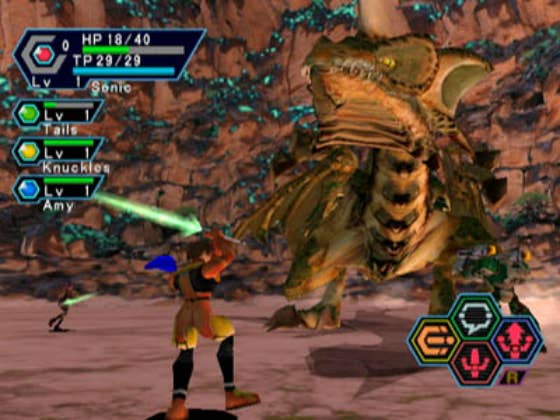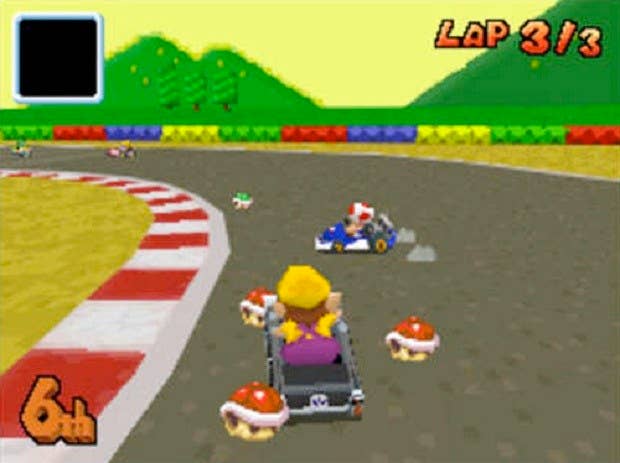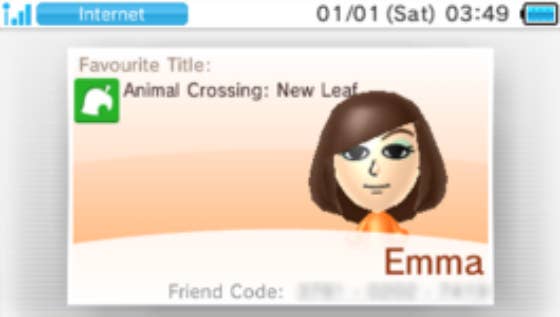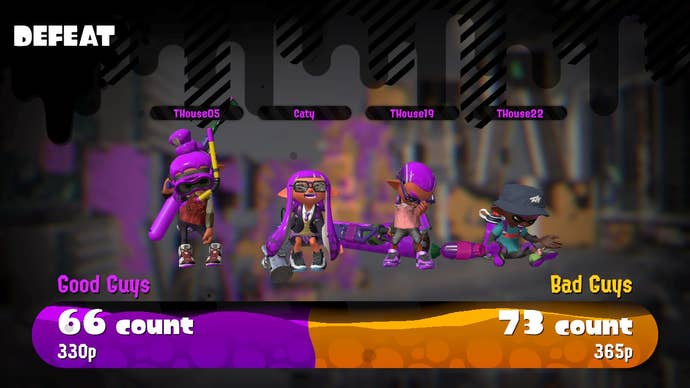The Slow, Stumbling History of Nintendo Online Support
Does Nintendo deserve the stigma of being behind when it comes to online services?
This article first appeared on USgamer, a partner publication of VG247. Some content, such as this article, has been migrated to VG247 for posterity after USgamer's closure - but it has not been edited or further vetted by the VG247 team.
When I wrote my article about the current status of Splatoon 2 online play and the Nintendo Switch Online smartphone application, I saw several responses around the internet. One of them was the perception that Nintendo has always been behind in online infrastructure, despite having years to catch up. Some say this perception is rooted in past practices of the Japanese giant. The fact is that while we've reached a stable plateau in online offerings, Nintendo still lags behind a bit.
As games like Mario Kart 8 Deluxe and Splatoon 2 have a stronger online focus, the problems Nintendo has in the space have begun to compound. As Switch owners ask for popular titles from other platforms, the comparisons to other platforms increase. Someone playing Overwatch, Destiny, or Call of Duty has certain expectations as to how online play should work. Nintendo has to meet those expectations.
The thing is, Nintendo has been, at least to some degree, behind the curve when it comes to online services. Thus, let's look at Nintendo's history of online support.

GameCube: Nintendo GameCube Broadband Adapter and Phantasy Star Online ver. 2
Back when the Nintendo GameCube was still code-named Dolphin, Nintendo and other companies seemed to realize that online networking was something that would be needed for the future of gaming. Statements from Nintendo designer Shigeru Miyamoto pointed to the push-and-pull that perhaps still hurts the company to this day: protecting a younger audience from the Wild West of the internet.
"There's got to be something Dolphin has with the Internet, because from now on we can't create entertainment without thinking about network communication," Miyamoto told GameSpot in 1999. "At the same time, we are an entertainment company so we have to take into consideration the cost associated with network games, and the ages of the users, who are actually going to make use of it. If we consider these two points right now, I have to tell you that there is not a big market right now for Dolphin to involve a significant Internet business."

Some months later, it was rumored that Nintendo was following Sega and Square Enix in the creation of a potential massively multiplayer online game. Sony Online Entertainment's Everquest had launched in March of 1999 and had already passed Ultima Online in subscriptions. Ongoing subscriptions meant ongoing revenue, and other publishers wanted to get in on that action. Comments from Miyamoto reiterated his statements above, but also pointed to Nintendo's other ongoing problem: the need to be different from competitors.
"I'm very interested in online gaming, and I fully understand why people are so enthusiastic about it. But, you know what Nintendo is about, and has always been about, is not doing the same as every other company. So, if it ever came to the stage where we were talking about online gaming, it would be because we had a new way to approach the idea. It wouldn't just be because everyone else is doing it," Miyamoto told UK N64 Magazine (via GameSpot).

The GameCube launched in 2001 in North America and Japan, but that Nintendo online game never materialized. The company produced and launched the Nintendo GameCube Broadband Adapter and Modem Adapter in 2002, but never released a game that supported the internet capabilities. Mario Kart: Double Dash!!, 1080 Avalanche, and Kirby Air Ride used the adapter for local area network (LAN) play, but the only actual online games were the Japan-only Homeland and Sega's Phantasy Star Online in various incarnations.
For Phantasy Star Online Episode I & II, Phantasy Star Online Episode I & II Plus, and Phantasy Star Online Episode III: C.A.R.D. Revolution, Sega handled the online infrastructure. Nintendo just provided the hardware to make it possible. The same was true of the PlayStation 2's online offerings via the PlayStation 2 Network Adaptor, which launched in Japan in 2001. Microsoft, being a company tied heavily to desktop PCs with Windows, was the first to offer a unified online service with Xbox Live for the first Xbox in November 2002.

Nintendo DS: Mario Kart DS and Friend Codes
Following Mario Kart: Double Dash!!'s support of LAN play, the next Mario Kart would actually support online play for the first time ever. In 2005, Mario Kart DS and Tony Hawk's American Sk8land for Nintendo DS were the first games to to support the new Nintendo Wi-Fi Connection. The Nintendo Wi-Fi Connection was the company's real shot at a unified online service where the DS could connect online via its built-in 802.11 wireless adapter. Players could also pick up the Nintendo Wi-Fi USB Connector for high-speed access.
This was the beginning of the infamous Friend Code system. Every copy of Mario Kart DS had an attached Friend Code, a 12-digit number that signified that copy of the game in tandem with a specific system. Players could share and register other Friend Codes to build their roster of friends.

The Friend Codes were fine on a smaller scale, but had a few issues. First, every player had to have all Friend Codes mutually registered on every system involved. Second, every player that wanted to join needed to be looking at their Friends list at the same time. Finally, there was no way to simply pick up a Friend Code or make an ad hoc connection without a Friend Code. It worked for local wireless play though, which was all Nintendo needed.
The problem was that Microsoft had reached two million registered Xbox Live users earlier in 2005. Xbox Live had a more elegant account system and it was easy for players to create a buddy list, voice chat, and play online. Microsoft would launch the Xbox 360 with an updated version of Xbox Live in November 2005, around the same time Nintendo was testing the waters with Mario Kart DS. A year later, Sony would offer a similar unified online system for its all-new PlayStation 3: the PlayStation Network.

Nintendo Wii: The Nintendo Wi-Fi Connection Expands
When the Nintendo Wii launched in November 2006, the company simply expanded the Nintendo Wi-Fi Connection to the new platform. Nintendo's online strategy was wrapped up in a single phrase: "simple, safe, free."
The Wii still used Friend Codes though, and players who wanted to become friends in a game had to mutually share codes. On top of this, Nintendo added WiiConnect24, which let games send data online even when the system was in standby mode. WiiConnect24's features tended to use a 16-digit Wii Number, which was tied to the system itself. Some games even used both the Friend Codes and Wii Numbers. Overall, it was more frustrating to connect with friends compared to Xbox Live or PlayStation Network (the latter of which was still free).

Nintendo was catching up though. With the Wii came the Wii Shop Channel for buying digital games via Wii Points, WiiWare indies, the Virtual Console, an internet browser, media services like YouTube, and several other connected online channels for weather and news. The Wii Message Board even allowed for messaging with friends and family.
Mario Kart Wii and Super Smash Bros Brawl were probably some of the bigger online-enabled Wii titles. Mario Kart Wii allowed up to 12 players to race at once. Super Smash Bros Brawl, once you had swapped Friend Codes, was easy to get into and start up a match. Both games had issues with hackers and griefers though. Since Nintendo didn't really have a unified system, there was no real way to ban or penalize these players.

Another major issue was the lack of game patches, which had begun to become more common in home console gaming. If there was a game with balance or other severe problems, developers on other systems could release a patch to fix the issues. On the Wii, that wasn't the case. When The Legend of Zelda: Twilight Princess launched with a game-breaking bug on Wii, Nintendo simply sent a new copy of the game to affected customers. This was probably because of the Wii's storage capacity, which was only 512 MB of flash storage.
In contrast, the Xbox 360 and PlayStation 3 were racing ahead in online features. Xbox Live and PlayStation Network users had single unified accounts. From those accounts they could play online games, purchase and download new games, grab demos, or use a wide variety of multimedia services. The Xbox 360 did launch with a harddrive-less Core unit, but developers considered the base 20 GB Premium model to be the default. The PlayStation 3 launched with 20 GB and 60 GB models. Downloading content and patching became the norm for those userbases. It didn't matter though, because the Wii was a hit with the "Blue Ocean," or average consumers who hadn't gamed before.

Nintendo 3DS: Friend Codes Improve
Nintendo launched the Nintendo 3DS handheld in early 2011. Along with the new system came a brand-new iteration of the Friend Code system. This time, Friend Codes were tied to your 3DS system and a Friend Card profile on that system. Players could add up to 100 friends on their 3DS, though the same basic issue with Friend Codes persisted: you had to mutually register Friend Codes, unlike Xbox Live and PlayStation Network, where you could send a friend request that would complete the handshake once accepted.
It was better, but not quite there yet.

Nintendo 3DS and Wii U: The Nintendo Network
The 3DS launched in 2011, but by January 2012, Nintendo realized that Friend Codes weren't going to be enough. The company announced the Nintendo Network, finally offering a unified account system for the 3DS and the upcoming Wii U. In talking about the Nintendo Network at the time, former Nintendo president Satoru Iwata said that the lack of a unified, strong online network is what caused the decline in Wii sales. (Though the system had sold 96 million units by that point, so I think you were okay Nintendo.)
"Unlike Nintendo Wi-Fi Connection, which has been focused upon specific functionalities and concepts, we are aiming to establish a platform where various services available through the network for our consumers shall be connected via Nintendo Network service so that the company can make comprehensive proposals to consumers," Iwata said, according to a report from Kotaku.
Players finally had a Nintendo Network ID. One ID could be tied to a 3DS system, while the Wii U would allow up to 12 IDs per system. With your Nintendo Network ID, you could access the Nintendo eShop to buy games, or just pass the time in the social setting of the Miiverse. The unified account let Nintendo catch up to Xbox Live and PlayStation Network, allowing players to use the same payment on both 3DS and Wii U eShops.

Games like Mario Kart 7 for 3DS used the Nintendo Network to allow for more seamless online play. The Nintendo Network let players view rankings and leaderboards, voice chat on the Wii U, and rate titles on the eShop. Miiverse integration let players share doodles and screenshots online.
The Wii U and 3DS also improved over the Wii by having the ability to patch games. Developers could finally offer updates to titles over time. Nintendo itself used the option to continue supporting games like Mario Kart 8 and Splatoon with free patches and further downloadable content. Multimedia services like Netflix, Hulu, and YouTube were important additions to both platforms.

But while Nintendo had reached near parity finally, PlayStation Network and Xbox Live were making incremental changes. Party chat became a standard feature on both networks, letting players chat with friends regardless of which game they were playing. Media services were a strong backbone of both systems, offering Blu-Ray playback and more in a bid to be the only box hooked to your television. Nintendo still lacked Trophies or Achievements, which were the sole focus of some players.
Nintendo standing on even footing would only last for one year. The Xbox One and PlayStation 4 would both launch in November 2013, pushing online offerings further. They carried forward Xbox Live and PlayStation Network, but there were new social features. Recording game videos and streaming gameplay to services like Twitch became a core part of both systems.

Taking screenshots on the PlayStation 4 was a breeze with the Share button and those screenshots could be moved to PC or shared directly from the system to Twitter or Facebook. Both the Xbox One and PlayStation 4 could send save data to the cloud, allowing you to pick up your saved games on another system simply by signing into your account. (This actually started on the PlayStation 3 with PlayStation Plus, but became the standard here.)

Nintendo Switch and Mobile: The Nintendo Account and... Friend Codes?
Ahead of the release of the Nintendo Switch, Nintendo announced a whole new unified account system, the Nintendo Account. The Nintendo Account isn't an online service in and of itself. Instead, it's a single login that ties together multiple Nintendo services.
Users can create a Nintendo Account by logging in with Facebook, Twitter, Google, an email address, or a Nintendo Network ID. Essentially, Nintendo killed the Nintendo Network for something a bit broader. Nintendo Accounts are the backbone of the Nintendo Switch, Nintendo Switch Online, the My Nintendo benefits service, and any of the Nintendo mobile games, including Super Mario Run, Fire Emblem Heroes, and Miitomo. Theoretically, it's one account for everything Nintendo does.

Except, it's not quite. Super Mario Run and Fire Emblem Heroes still have friend code-style systems to connect players, as does the Nintendo Switch itself. On the Switch, the Friend Code is attached to your Nintendo Account profile, not the system. It's easier than before, no longer requiring players to mutually add each other. Instead, you send a friend request with a code and the other person just has to accept. The Switch also lets you search for local users in your area and easily friend users you've recently played with. Nintendo later added Friend Suggestions, which pulls from your Nintendo Network friends lists or those you've friended on Super Mario Run and Miitomo.
Basically, it's not quite just searching for a friend's name, but it's not bad at all.


Nintendo took a few steps back though. The Nintendo Switch has no built-in voice chat and the new Nintendo Switch Online service requires an app. Features that are system level on other consoles—even on Nintendo's earlier efforts—are now shunted off to a smartphone application. Voice chat is tied to private rooms within specific titles, even with the app.
Games like Mario Kart 8 Deluxe and Splatoon 2 rely on a lobby system, meaning if you want to play with a friend, they have to join a game in progress and hope there's an open slot. If either of you disconnect, there are issues rejoining your friend. Which is a problem, because Nintendo's servers have caused Mario Kart 8 Deluxe players to complain about significant lag and disconnects.
Basically, Nintendo had achieved a level of parity, only for Xbox Live and PlayStation Network to move further ahead. The app for Nintendo Switch Online is fine as an optional measure—PlayStation Network has the PlayStation app to provide similar features—but things like partying with friends and chatting should be a part of the system itself. The app itself is limited, especially in comparison to other smartphone-based options like Discord. Listening to voice chat and game audio requires a splitter solution if you want to use headphones.

This is where we are currently. This hope that one of the major platform holders in the industry would take the time to look at other competing services and attempt to achieve some measure of equality. But Nintendo doesn't seem keen to. This is backed up by an account from an anonymous developer posted on Eurogamer in regards to the Wii U.
"There were apparently issues with setting up a large networking infrastructure to rival Sony and Microsoft that they hadn't envisaged," wrote the developer. "This was surprising to hear, as we would have thought that they had plenty of time to work on these features as it had been announced months before, so we probed a little deeper and asked how certain scenarios might work with the Mii friends and networking, all the time referencing how Xbox Live and PSN achieve the same thing."
"At some point in this conversation we were informed that it was no good referencing Live and PSN as nobody in their development teams used those systems so could we provide more detailed explanations for them? They were trying to play catch-up with the rival systems, but without the years of experience to back it up."

Especially in an era where online play is key, this just doesn't work. Porting games like Overwatch over to Switch probably won't happen, because the online features just aren't there. Effectively, Nintendo's already removed the system from the conversation before even getting to graphical power.
Nintendo fans are a resilient bunch and have survived without online parity for years. But they shouldn't have to. Nintendo has a warchest in the bank that absolutely dwarfs many other companies. They have the money and potential resources to fix this problem. Ideally, this should be something Nintendo could be able to provide. Instead, we wait and hope the situation improves in the future. Which is pretty normal on Nintendo platforms with regards to online, as its history proves.
That's a shame, because otherwise the Nintendo Switch is a complete winner. Hopefully Nintendo will get the online on track, sooner rather than later.









